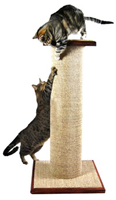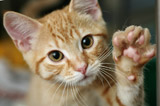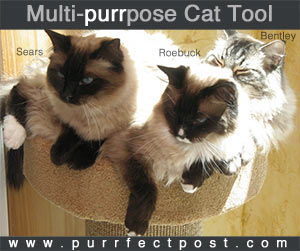Cat Declawing Alternatives
There are many solutions to problem cat scratching that do not involve declawing. Since declawing involves ten separate amputations of the distal phalanx, which is comparable to amputating the last joint of a human finger, alternatives to this drastic and painful procedure should be explored.
Soft Paws Nail Caps for Cats
Developed by a veterinarian, Soft Paws are nail caps that look like a cat's nail, but are hollow inside. The nail caps easily fit over the cat's nail and are secured with a safe, non-toxic adhesive. Soft Paws effectively blunt the claws so that when a cat scratches , no damage occurs. The nail caps stay on for about four to six weeks and fall off with the natural growth of the cat's nails. They are generally very well tolerated by most cats, with most cats not even noticing they are wearing them. Some cats will groom them a bit excessively at first, resulting in them coming off sooner, but any removed nail caps can be easily replaced. Soft Paws should not be used on cats that go outside, since nail caps will blunt the claws and also impede a cat's defenses. To learn more about Soft Paws, click here.
Cat Scratching Posts
Cats will always scratch, it is in their nature. The key is to provide your cat with a post that he/she prefers over your furniture.
So what makes a good scratching post?

- Height. The post needs to be tall enough for your cat to stretch and extend in order to get a full and satisfying scratch. The picture to the right shows a good example of a cat getting a "full and satisfying" stretch.
- Stability. The post must be stable. If it wobbles, your cat won't like it, and if it topples over your cat won't want to get near it again. Watch a cat scratch — they hunker down and scratch and pull with such vigor that they need a stable surface to suit their scratching needs.
- Material.The best material for cat scratching posts is sisal fabric. Not sisal rope, but sisal fabric. This woven material provides great texture for shredding — which cats love to do when scratching, and it feels good on their paws. When a cat scratches the sisal material, he can drag his claws down this satisfying material over and over in a continuous motion. In contrast, sisal rope creates an interrupted scratch — scratch, bump, scratch, bump, scratch, bump. Not very satisfying.
Purrfect Post — a tall, stable, sisal fabric-covered scratching post.
A purrfect example of the right type of scratching post, (which cat post lovers are actually calling legendary), is the Purrfect Post. It encompasses all of the above attributes and is attractive-looking for humans too. This is important, since the post must be in a prominent area of your living space to be effective. The post is designed by a veterinarian and has a money-back guarantee if your cat doesn't absolutely love it. Click here to view the Purrfect Post and check out the Mondo and Purrfect View too.
Location, location, location.
So you find the right scratching post for your cat. Now one of the keys to getting him to use it is to place it in a prominent area of yours, and his, living space. Why? Because one of the reasons cats scratch is to mark their territory, so the post has to be in the places your cat likes to be. Learn more about placement of the post and training your cat to use a post.
Double-Sided Tape
Double-sided tape, such as Pioneer Pet Sticky Paws on a Roll Cat Deterrent is sticky on both sides. Simply apply it to the objects you would prefer your cat not scratch on, and his natural aversion to stickiness will put an end to the offending behavior. The tape works as an aversion tool, but you still need to provide a place for kitty to scratch — such as a scratching post.
Feliway
Feliway is a synthetic analogue of the feline facial pheromone — sounds confusing, but it is really quite simple. Have you seen cats rubbing their cheeks on an object? What they are doing is depositing some of this facial pheromone on the object and marking it as theirs. This feline facial pheromone can also be thought of as a feel good pheromone. Meaning cats sense this pheromone and it has a calming effect.
Cats are territorial by nature, and like to delineate their territorial boundaries. Scratching is one of the ways cat mark their territory. Not only does scratching provide a visual marking of the territory (the shredded material) but also, cats have scent glands on the bottom of their paw pads which deposit a scent discernible only by other cats.
Spraying Feliway on objects you do not want your cat to scratch effectively depositis this feel good pheromone so your cat doesn't feel the need to scratch the object.
You will still need to provide a scratching post so there is a place for your cat to scratch.









